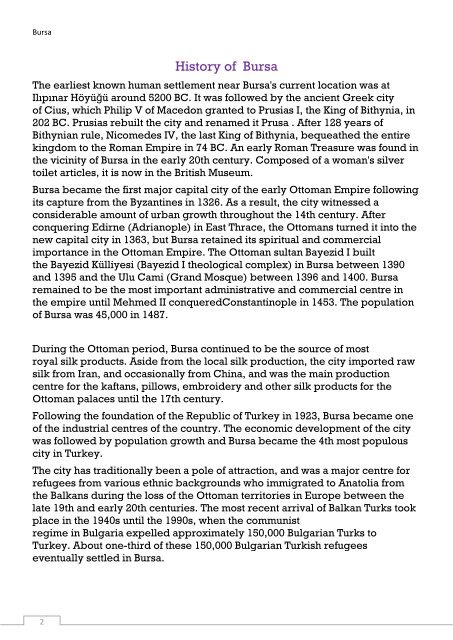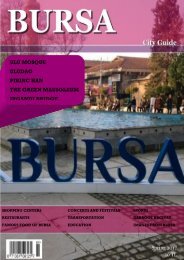You also want an ePaper? Increase the reach of your titles
YUMPU automatically turns print PDFs into web optimized ePapers that Google loves.
Bursa<br />
History of Bursa<br />
The earliest known human settlement near Bursa's current location was at<br />
Ilıpınar Höyüğü around 5200 BC. It was followed by the ancient Greek city<br />
of Cius, which Philip V of Macedon granted to Prusias I, the King of Bithynia, in<br />
202 BC. Prusias rebuilt the city and renamed it Prusa . After 128 years of<br />
Bithynian rule, Nicomedes IV, the last King of Bithynia, bequeathed the entire<br />
kingdom to the Roman Empire in 74 BC. An early Roman Treasure was found in<br />
the vicinity of Bursa in the early 20th century. Composed of a woman's silver<br />
toilet articles, it is now in the British Museum.<br />
Bursa became the first major capital city of the early Ottoman Empire following<br />
its capture from the Byzantines in 1326. As a result, the city witnessed a<br />
considerable amount of urban growth throughout the 14th century. After<br />
conquering Edirne (Adrianople) in East Thrace, the Ottomans turned it into the<br />
new capital city in 1363, but Bursa retained its spiritual and commercial<br />
importance in the Ottoman Empire. The Ottoman sultan Bayezid I built<br />
the Bayezid Külliyesi (Bayezid I theological complex) in Bursa between 1390<br />
and 1395 and the Ulu Cami (Grand Mosque) between 1396 and 1400. Bursa<br />
remained to be the most important administrative and commercial centre in<br />
the empire until Mehmed II conqueredConstantinople in 1453. The population<br />
of Bursa was 45,000 in 1487.<br />
During the Ottoman period, Bursa continued to be the source of most<br />
royal silk products. Aside from the local silk production, the city imported raw<br />
silk from Iran, and occasionally from China, and was the main production<br />
centre for the kaftans, pillows, embroidery and other silk products for the<br />
Ottoman palaces until the 17th century.<br />
Following the foundation of the Republic of Turkey in 1923, Bursa became one<br />
of the industrial centres of the country. The economic development of the city<br />
was followed by population growth and Bursa became the 4th most populous<br />
city in Turkey.<br />
The city has traditionally been a pole of attraction, and was a major centre for<br />
refugees from various ethnic backgrounds who immigrated to Anatolia from<br />
the Balkans during the loss of the Ottoman territories in Europe between the<br />
late 19th and early 20th centuries. The most recent arrival of Balkan Turks took<br />
place in the 1940s until the 1990s, when the communist<br />
regime in Bulgaria expelled approximately 150,000 Bulgarian Turks to<br />
Turkey. About one-third of these 150,000 Bulgarian Turkish refugees<br />
eventually settled in Bursa.<br />
2



